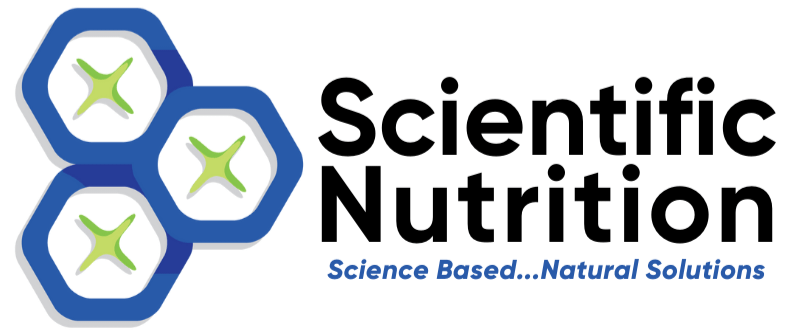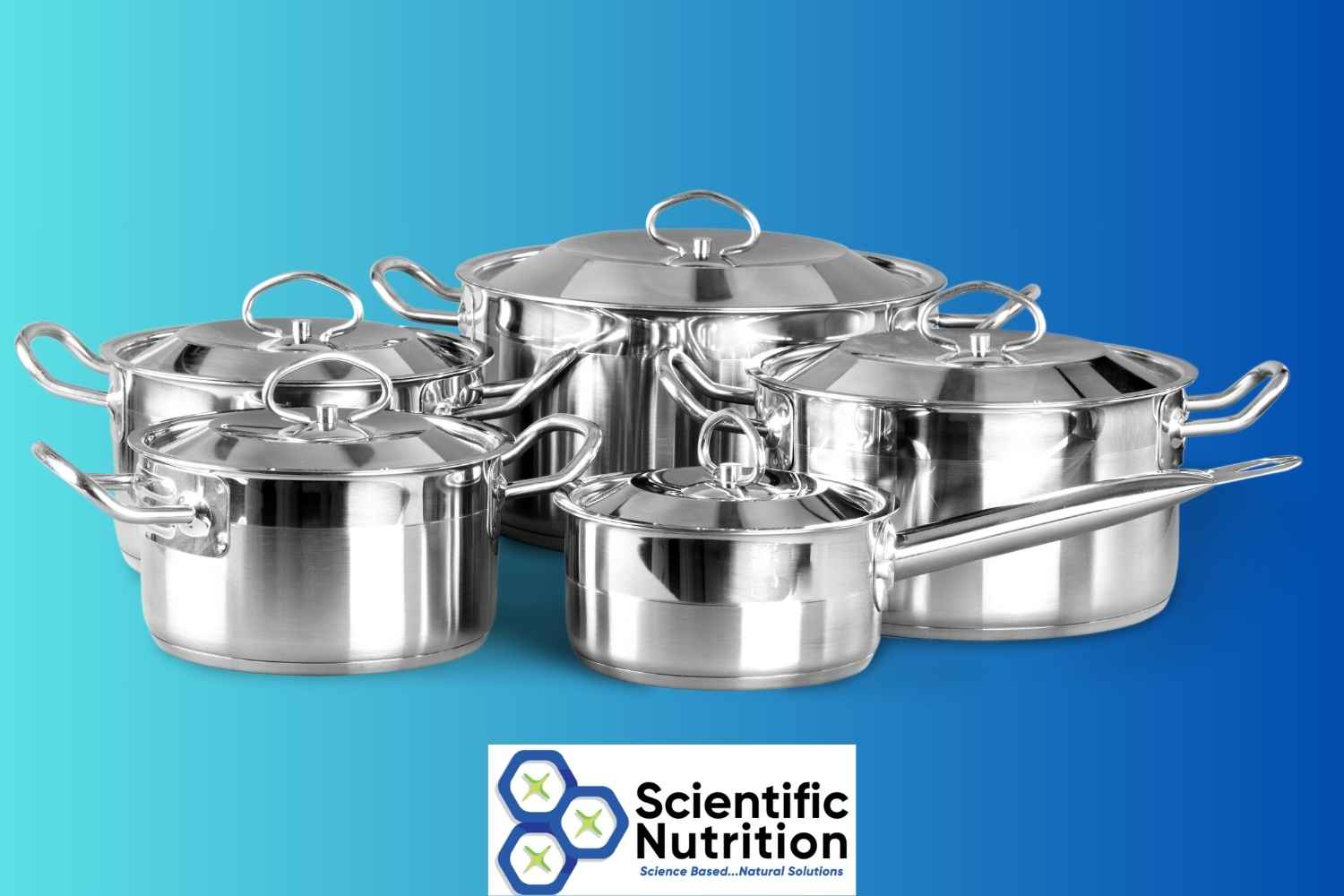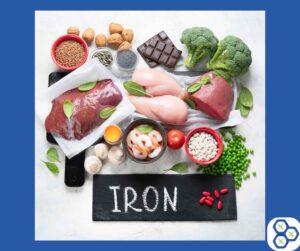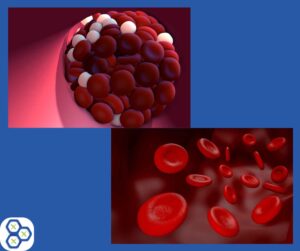What is the safest cookware that is non-toxic for my health?
Over the years, I’ve received countless questions about the safest cookware to buy. As more people become aware of the dangers of heavy metal toxicity, the need for non-toxic cookware has never been more important. Many brands of cookware options can leach harmful chemicals and heavy metals into your food. These toxins, like lead, cadmium, and PFOAs, have been linked to various health issues, including cancer, hormonal imbalances, and neurological disorders.
The main culprits found in “stainless steel” are Chromium, Nickel, Lead, Cadmium, and Aluminum. The alloys are created to make the cookware more durable or cheaper to produce.
Using the safest cookware can stop a lot of toxins from entering your body daily. A quality brand of cookware will last you a lifetime which is an investment in your health.
The need for non-toxic cookware
From my experience and research, switching to non-toxic cookware can significantly reduce exposure to these dangerous substances. Non-toxic cookware is made from materials that do not react with food, even when cooking at high temperatures. This means your meals remain pure and free from harmful contaminants.
In this blog post, I will share the safest, non-toxic cookware to help you eat healthy. Later I will explain non-toxic cookware hazards, but first let’s understand how to test for toxic cookware, healthy brands, and how the toxins might be impacting your health.
How can I test my cookware for safety?
FAQs
To test your cookware for safety;
- The first method is to check to see if a magnet sticks to the inside of the cooking surface. The cookware likely contains no nickel or other harmful alloy metals if it sticks.
.
- The second method is to boil 2 Tablespoons of white vinegar in a pot or pan. After cooling, taste the vinegar. If it tastes metallic, the cookware might be alloy-based and potentially unsafe. Compare the taste to a glass of the same amount of vinegar for accuracy. If the acidity pulls metal-tasting water, find a new product.
These simple tests can help determine if your cookware is safe and free from harmful metals.
4 Types of nontoxic cookware that I highly recommend
For the safest cookware, there are four types I recommend:
1. The Best stainless steel
Stainless steel cookware is a top choice for non-toxic cooking. Look for high-quality stainless steel with at least 10.5% chromium content, ensuring durability and rust resistance. At the very most 1.2% carbon as well as iron (which makes it magnetic) is to be labeled as stainless steel. They may contain nitrogen, silicon, and manganese as well so quality is very important.
They use multi-ply construction, combining stainless steel with aluminum or copper cores for even heating without the risk of chemical leaching. When choosing stainless steel, make sure it is labeled as 304 or 316 grade, indicating low nickel and high corrosion resistance. Brands like Diamondcraft are an excellent option.
A possible secondary solution is Calphalon Tri-Ply or All-clad Stainless. They however are not clearly labeled, contain polymers, and use 18/10 (higher nickel) mixed metals even when not indicated on the pan itself. Ensure you are investing in the best quality to last a lifetime. You will not only save time replacing lesser quality products, you will not sacrifice your health!
I use Vital Nutrition by Diamondcraft cookware brand we purchased over 28 years ago. They have 5 to 7-ply surgical stainless steel with an oil core for water-less cooking. Boiling your food, you’ll lose 30-50% of vitamins and nutrients, compared with 2-5% with Diamondcraft.
They are handcrafted in the USA and still look new after cooking for my family of 6 with them for over a quarter of a century. The investment was well worth it as they have a lifetime warranty and have replaced a lid steamer for free (as I wore it out).
Here are three types of stainless steel that you can choose from;
What is Austenitic stainless steel
Austenitic Stainless Steel: Often made of metal alloys labeled as 18/8 or 18/10, indicating the percentage of (18%) chromium and (8-10%) Nickel. It is the most common type used in cookware. The exception is if you have a cold worked grade austenitic stainless steel with the numbers 304 (SS304) or 316 (SS316) stamped on it. It is durable, non-magnetic, and resistant to corrosion.
Look for grades 304 (SS304) or 316 (SS316) for the best quality. 316 stainless steel offers better resistance to corrosion as well as being non-magnetic. Either may be tested by seeing if a magnet sticks on the inside, this would be a good thing showing no nickel where food is cooked.
Avoid anything stamped with 31655 as it contains toxic molybdenum that can pull copper out of the body. As a result, you can become copper anemic.
What is Ferritic stainless steel?
Ferritic Stainless Steel: This type contains chromium and is magnetic due to its lower nickel content. It’s cost-effective but may still contain some heavy metals chromium, molybdenum, or titanium to increase durability (so I don’t usually recommend it). You can choose high-quality brands, which have less to no contamination.
What is Martensitic stainless steel?
Martensitic Stainless Steel: This type includes added carbon, making it tempered or harder, and mostly suitable for razors, knives, and scissors. It is magnetic, made of high-quality materials, and may provide a safe cooking surface void of harmful metals.
Stainless made in other countries may not have the same standards and may release low levels of Nickel and Chromium. This is especially true if you are cooking acidic foods such as tomato-based sauces.
2. Ceramic cookware
Ceramic cookware is another great, non-toxic option. It is kiln-baked quartz or sand surfaces are best.
Items that are coated with nonstick coating contain titanium dioxide. This toxin can damage sperm, affect male fertility, and damage the liver, testicles, heart, brain, and kidneys. It also alters the gut microbiome and is rightly banned in France.
Avoiding glazed products is highly recommended as they may contain heavy metals such as lead.
Ceramic, unlike traditional non-stick pans, ceramic cookware is free from harmful chemicals like PFOAs and PFAs. Here are a few brands I recommend:
- Caraway Cookware: Known for its stylish design and non-toxic ceramic coating, Caraway cookware is free from PTFE, lead, cadmium, and other toxic materials. It provides excellent heat distribution and a non-stick surface, making cooking and cleaning easy.
.
- GreenPan: This original brand of GreenPan uses a ceramic non-stick coating called Thermolon, free from PFAs, PFOAs, lead, and cadmium. GreenPan’s products are known for their durability and healthy cooking performance. It has an aluminum coating under the ceramic which is derived from sand and applied without toxic chemicals, making it a safe and eco-friendly choice. This is a good quality pan that will last for many years.
.
- Xtrema: Xtrema cookware is made from pure ceramic and is third-party tested. This ensures it contains no harmful heavy metals (lead, cadmium, etc.) or toxic substances to leach into food. It’s free from glues, dyes, coatings, glazes, or polymers, making it one of the safest options available. Xtrema’s kiln-baked surfaces provide excellent heat retention and a truly non-toxic cooking experience.
3. Cast Iron – Best for slow cooking
Cast iron cookware is a staple in many kitchens for good reason. It’s naturally free from harmful chemicals and can improve iron intake when cooking. This cookware is best for slow-cooking methods like braising, baking, and frying. Its ability to retain heat makes it ideal for dishes that require steady, even cooking.
Brands like Lodge offer high-quality, durable options that can last quite literally for generations. To keep your cast iron non-toxic and non-stick, ensure you season them well by coating them with oil and heating them. This process creates a natural, non-stick surface that enhances over time, making cast iron a reliable and healthy choice for your kitchen.
4. Carbon Steel – lighter weight & faster heating
Carbon steel cookware is perfect for high-heat cooking, such as searing, sautéing, and stir-frying. It heats up quickly and evenly, which is great for recipes that need precise temperature control. Unlike cast iron, carbon steel is lighter and easier to handle, making it a practical choice for everyday use.
Brands like Made In and de Buyer have the highest standards for their exceptional carbon steel pans. Blue Carbon Steel and Lodge also make a quality pan. The pans are made of iron with a carbon steel coating to stop toxins from leaching into your food. They can handle temperature changes faster allowing foods to cook more evenly than cast iron.
These pans develop a natural, non-stick surface with regular seasoning. The seasoning process involves coating the pan with a thin layer of oil and heating it, similar to maintaining cast iron. This creates a durable, non-toxic cooking surface that’s versatile and long-lasting.
Tips for Safer Cooking:
- Use silicone or wooden utensils: Avoid scratching pots and pans to prevent exposure to harmful underlying metals.
- Soak rice overnight: Use a 2:1 water-to-rice ratio and rinse to reduce arsenic levels by up to 80%.
- Quick soak method: If short on time, use a 5:1 water-to-rice ratio and rinse before and after cooking to cut arsenic levels in half.
- Avoid plastic utensils: Prevent releasing hormone-disrupting chemicals by ditching plastic. Use rounded wooden ones.
- Choose high-quality, non-toxic cookware: Minimize exposure to harmful substances to your body and maintain kitchen safety.
Which bakeware is safest?
The safest bakeware options include using Pyrex-type glass dishes, stoneware tested for heavy metals, and surgical-grade nickel-free stainless steel bakeware. These materials prevent harmful substances from leaching into your food. By adding a layer of protection of non-bleached parchment paper between the food and bakeware you can stop leaching.
I’m not 100% sure that silicone baking dishes are safe from chemical contamination so until studies confirm their safety, avoid them. Opting for these safer materials helps maintain a non-toxic kitchen environment and ensures your baked goods are free from harmful contaminants. Silicone toxicity is something you do not want to risk suffering from.
Which chemicals are found in cookware?
The safest cookware will not contain chemicals or release them while cooking at medium to high heat. Two found in cookware include PFAs (per- and polyfluoroalkyl substances) and PFOAs (perfluorooctanoic acids). They are among the most dangerous and common ones you can eliminate by choosing better pots and pans.
PFAs are man-made chemicals in the air, water, and soil. They are in non-stick coatings and within many household products. Most commonly these chemical toxins have been found in 97% of Americans! The issues that may occur from frequent exposure are fertility, low growth, slower metabolism, obesity, suppressed immune system, and increased risks of cancers.
PFOAs are life-long chemicals that are stuck in tissue that can affect your reproduction, liver health, and children’s growth and development. It is primarily within Teflon-coated cookware. It retains in the body and the environment while affecting your reproduction, liver health, and our children’s development.
This toxic chemical is globally in the blood of most mammals (even whales). Boiling water will not remove it but using a good water filter such as Berkey or ZeroWater’s 5-stage filter will cut the amount significantly. Both chemicals are persistent, meaning they don’t break down and can accumulate over time, posing significant health risks.
Which heavy metals are found in cookware?
Heavy metals commonly found in cookware include lead, cadmium, nickel, and aluminum. Here are some symptoms they can cause in relation to the specific heavy metal:
Lead toxicity can cause abnormal brain function, blindness, convulsions, deafness, dyslexia, encephalitis, epilepsy, insomnia, multiple sclerosis, muscular dystrophy, Parkinson’s disease, vertigo, arteriosclerosis, atherosclerosis, colic, constipation, weight loss, spontaneous abortions, infertility, hypothyroidism, cancer, diabetes, hypoglycemia, anxiety, poor concentration, mood swings, nightmares, psychotic behavior, and alopecia.
Cadmium toxicity tends to harden and inflame the arteries leading to arteriosclerosis, atherosclerosis, impaired circulation, hypertension, heart failure, cancer, hypoglycemia, diabetes, mental illness, bone pain, osteoporosis, tendon problems, damage to all body organs, loss of sense of taste, wound healing delayed, migraine headaches, psoriasis, kidney failure.
Nickel toxicity can cause kidney dysfunction, heart attack, oral cancer, intestinal cancer, skin problems, nausea, vomiting, hemorrhages, malaise, low blood pressure, muscle tremors, tetany, and paralysis. Nickel affects the mind and emotions deeply. It also has links to fears, anger, depression, and suicidal thoughts.
Aluminum toxicity can trigger flatulence, headaches, dryness of skin and mucous membranes, tendencies for burning pain in the head relieved by food, loss of memory and mental confusion, some dementias, and reduced sweating. Later symptoms include Alzheimer’s disease, other dementias, amyotrophic sclerosis, anemia, colitis, dental cavities, kidney and liver dysfunction, neuromuscular disorders, and Parkinson’s disease. Avoid aluminum cookware for all of these reasons as well.
Learn more about heavy metal toxicity HERE.
Hair Analysis and Non-toxic cookware are as important as a healthy diet
You invest hundreds of dollars shopping for quality ingredients and food items, but if your cookware contains toxic chemicals, your money will go to waste. Always be very careful when choosing the cookware you will use daily.
If you want to know more about heavy metal toxicity or would like to discuss your health…
Let’s Chat about your goals!
Learn about seeing where your heavy metal toxicity levels are and how to remove them through Hair Analysis.
Copyright Scientific Nutrition, LLC 2023, updated 2024




